February is International Hoof Care Month, so come behind the scenes for an up-close look at giraffe hoof care training! Hoof care is important for the overall health of all hoofstock animals. Brushing, picking, and trimming contribute to maintaining healthy hooves, directly influencing the health of a giraffe’s entire body. At CMZoo, keepers have built trust with the giraffe herd through positive reinforcement, offering them the choice to train with their favorite crackers or walk away.
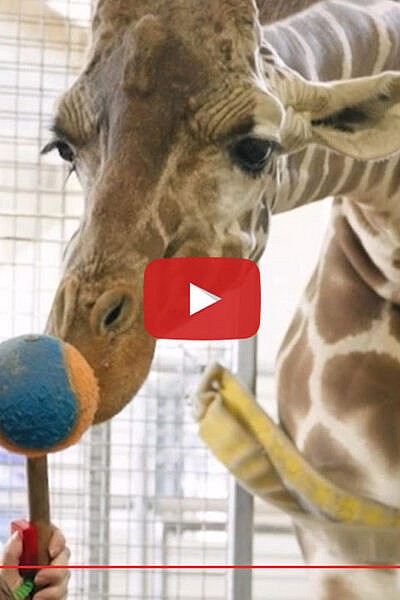

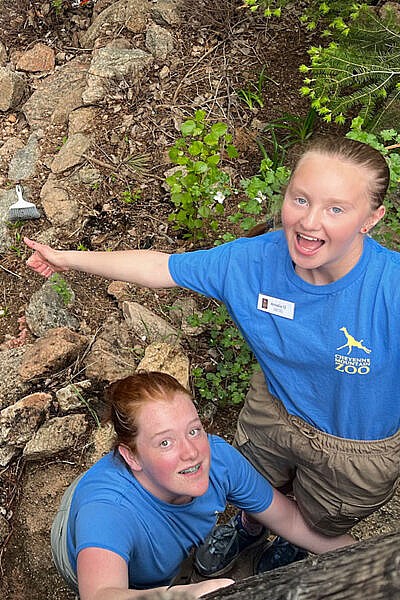

Cheyenne Mountain Zoo’s Teen Summer Program has inspired and prepared future biologists and conservationists for decades. Soon, it will welcome new and returning participants for summer 2024. Applications for the highly competitive program for sixth through 12th graders open Thurs., Feb. 1 at cmzoo.org/teenprograms. Applications will only be accepted for two weeks, so nature-loving teenagers should start considering the program now.
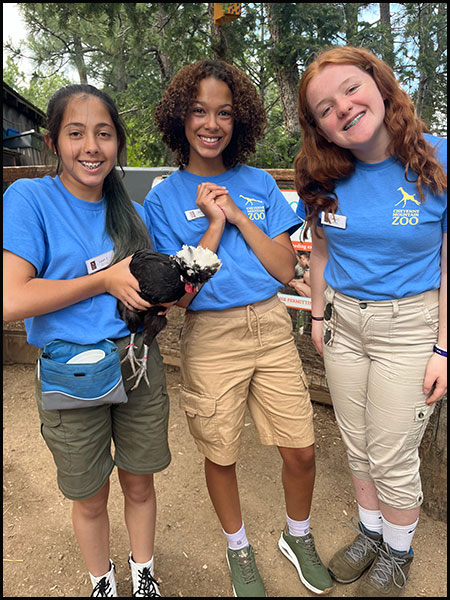
From Mon., May 27 through Fri., Aug. 9, 2024, Teen Summer Program participants will work alongside CMZoo staff to interact with animals, guests, keepers and each other. Mabel Kim has been in the Teen Program since the summer before her high school freshman year, and in 2024, she intends to come back for her fourth year.
“Some might assume the Teen Program at the Zoo is all about animals, but it’s one of the richest experiences like this you can get in Colorado Springs,” said Kim. “I’ve learned presentation skills, public speaking, mentoring, writing a resume, interviewing and more. It’s a really fun environment, and we do focus on animals and conservation. Because of this program, I feel prepared to apply for college, internships and jobs.”
In addition to gaining valuable experience working at CMZoo, teen participants learn to be nature’s best stewards with life-changing experiences off Zoo grounds, in Colorado’s wild places and beyond. Teens can expect educational, inspirational experiences, like whitewater rafting, camping, rock climbing, mountain biking, visiting local animal sanctuaries and Associations of Zoos and Aquariums-accredited zoos, and learning to be a leader and an advocate for wildlife and wild places.
“Ultimately, we hope that by offering these experiences that connect the hands, the heart, and the mind to the natural world, these teens will stand up for, and advocate for, the wild places and wild animals of our world,” said Austin Kennedy, CMZoo Extended Education Supervisor. “We focus on leadership training, animal husbandry, interpretation and public speaking, empowerment, and so much more.”
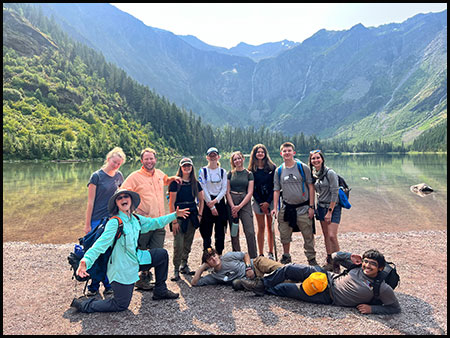
Participants also have the chance to go on an EdVenture Trip with the team, led by EdVenture staff. In 2023, the teens embarked on a six-day off-grid adventure to the wilderness of Glacier National Park. [LINK TO: https://www.cmzoo.org/news/archive/teen-program-inspires-the-next-generation-of-land-and-wildlife-stewards-in-glacier-national-park/] This year, managers are planning for another excursion full of adventure and nature-inspired leadership learning.
“I can’t encourage people enough to apply,” said Kim. “Definitely go for it. You’ll have amazing opportunities with animals, but you’ll also learn real-life and career skills. Plus, you’ll form bonds and make friendships with people who have similar interests, like science, nature, conservation and advocacy.”
EdVenture staff recommends each teen commits to a minimum of 120 program hours for the season. However, to complete the program, there is no minimum or maximum number of participation hours required.
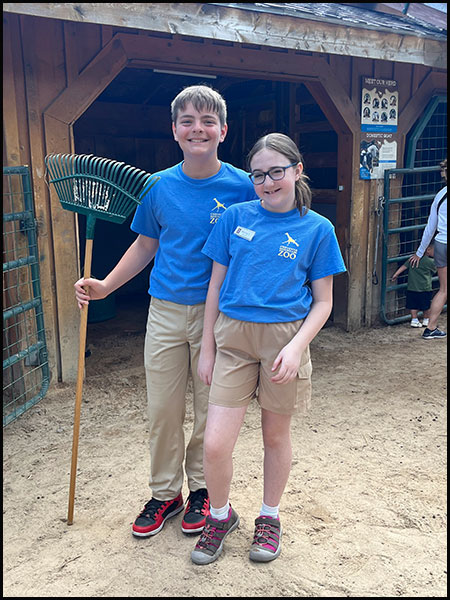
Applications are open Thurs., Feb. 1 until Wed., Feb. 14 at midnight MT. The non-refundable application fee is $25, and no late applications will be accepted. Typically, only one-third of those who apply will be accepted.
After the application period, EdVenture staff conducts interviews with candidates, and ultimately accepts about 100 teens to the summer program. CMZoo’s Teen Summer Program is a tuition-based experience, and scholarships are available. Participation in EdVenture trips requires a separate fee.
If a summer timeline won’t work, consider participating in an off-season Teen Program. The Teen Winter Program runs November through February, with applications opening for two weeks each October. The Teen Spring Program is only open to teens who have participated in a Teen Summer or Winter Program. The spring session runs February through May, with applications opening for two weeks each January.
For more information – and to apply between Feb. 1 and 14 – visit cmzoo.org/teenprograms.
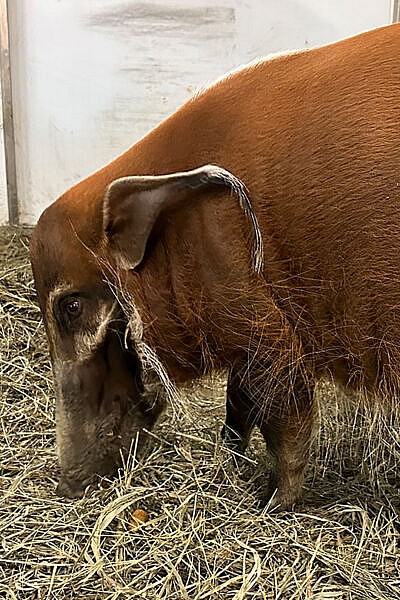

Two redheaded charmers from Texas arrived in African Rift Valley earlier this month, complete with gorgeous ear tassels and pointy hooves. While they complete their routine quarantine period behind the scenes, Red River hog sisters, Rey and Finn, are cooing their way into the hearts of their keepers. Hopefully, the Zoo’s male Red River hog, Augustus, will be just as excited to welcome them to the family.
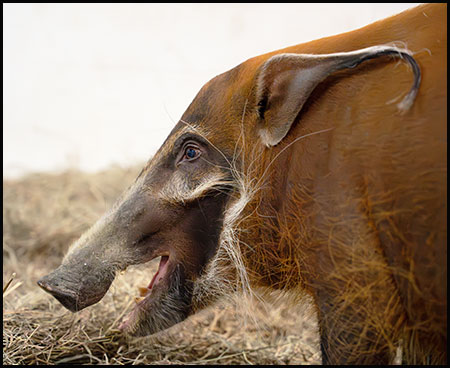
After their quarantine, they’ll start exploring more spaces and getting to know 17-month-old Augustus, known as “Gus” around here. In the meantime, keepers are getting to know the girls.
“They’re gorgeous animals, and these two are extremely vocal,” said Lauren Phillippi, lead animal keeper in African Rift Valley. “They have been making quiet, content ‘cooing’ sounds to each other and to us when we approach them. They like to do things together, like forage, solve puzzle feeders, roll around in the hay and snuggle while they sleep.”
The 7-year-old sisters were born in the same litter at another zoo accredited by the Association of Zoos and Aquariums. Rey is the leader of the two, and she is a bit bigger than Finn. Rey has darker orange-brown coloration compared to Finn’s much lighter white-and-brown face. Finn is a little more cautious. Being bold and outgoing, Rey is quick to approach keepers, wasting no time to communicate that she is a big fan of belly rubs.
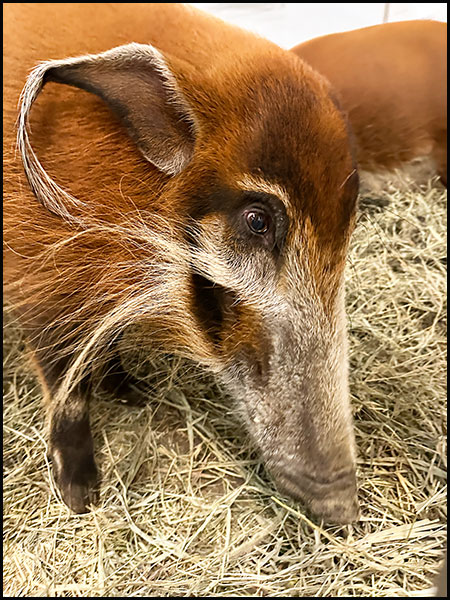
“We quickly noticed how tactile these two are,” said Phillippi. “They enjoy enrichment that requires a lot of motor skills, and they like to get scratches from keepers. Especially Rey.”
Keepers use wooden back scratchers and their hands to give Rey the tactile interaction she likes. Just a few seconds into a scratch session, 165-pound Rey gives an enthusiastic lean and a floor-shaking plop onto her side. She knows how to give keepers every opportunity to scratch her sides, belly and back. Her care team is happy to oblige.
“We’re using this time to develop relationships with them,” said Phillippi. “We want to build that rapport and make sure they know that they’re going to live with choice and control here.”
Finn and Rey are already willingly approaching keepers and staff from behind a protective barrier. They’re also taking training treats well and moving to different spaces when asked. Next, keepers will work on target training and then more complex voluntary behaviors that allow them to care for the girls.
The big question: when will the sisters meet Gus? Finn and Rey are used to sharing space with other hogs, as is Gus. Once the sisters have completed quarantine, the team will introduce the group with a protective barrier between Gus and the girls. Then, based on the hogs’ behaviors toward each other, they’ll move towards sharing space without barriers between them.
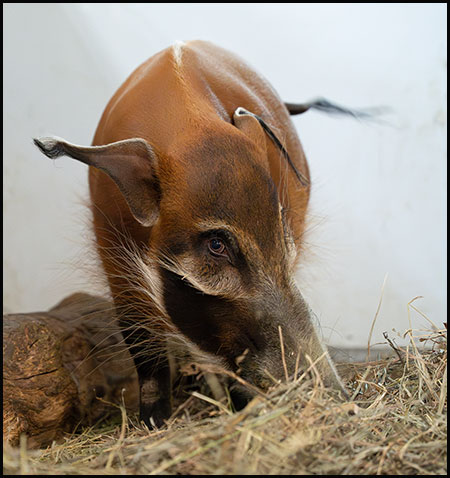
The goal is for all three hogs to live together full-time. Red River hogs are social animals, often living in groups, and Finn and Rey came to CMZoo on a breeding recommendation with Gus. At 17 months old, Gus is approaching the age when Red River hogs typically reach reproductive maturity. Red River hogs’ usual breeding season ends in April, so depending on their interactions and Gus’ maturity, hoglets could be here as soon as this summer. More likely, their first chance at reproducing will be next year.
If the hogs eventually welcome babies, all three would be first-time parents, making their genetics valuable to the Red River Hog Species Survival Plan and the population in human care.
When Finn and Rey are ready to explore spaces where guests can see them, the Zoo will provide updates.
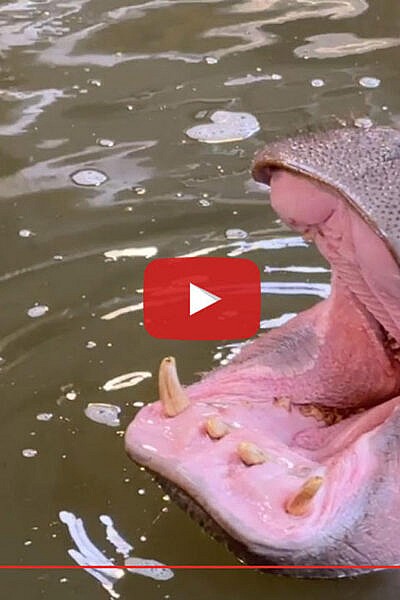

Rambunctious ‘Baby’ Omo has discovered little joys like the feeling of the hose on his gums and the excitement of exploring on his own while still living under the protective eye of his mom, Zambezi. At two and a half years old, Omo is learning and refining foundational training behaviors while also regularly getting the zoomies.
Omo and Zambezi still live together full time but are working on training in different spaces with the doors open between them. With a 1,300 pound ‘hippo tween’ always at the ready to play, Zambezi continues to nurture and teach her wiggly son while recently discovering the little joys of solo time. This time allows Zambezi and Omo some one-on-one time with their care teams and the opportunity to learn, grow, and rest in different ways.


A sleek, high-energy, 2-year-old domestic ferret named Blizzard recently joined ferrets, Cyclone and Alfred, in The Loft. She quickly made friends with the other ferrets, especially Cyclone, and is already comfortable with her new keepers and training. Visit Blizzard in her new home during your next visit to CMZoo!
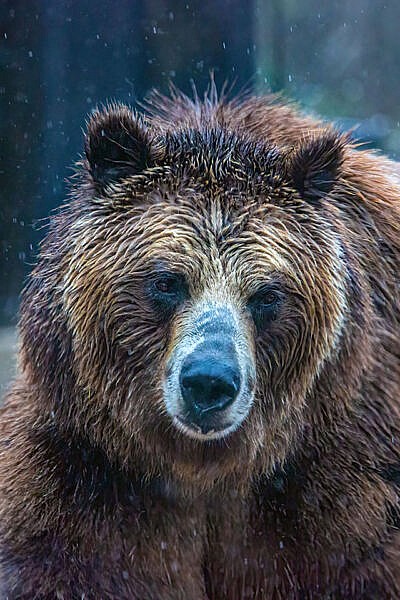

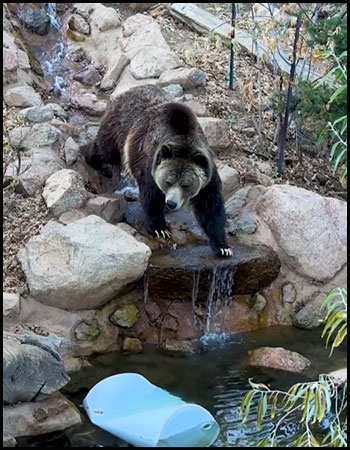 Guests and members will soon get new views of Emmett and Digger, CMZoo’s nearly 19-year-old grizzly bears. When the project is complete, visitors will get different perspectives of the bears from ground level and from an additional guest viewing area. Ongoing improvements to the bears’ habitat – including the recently completed waterfall in their north yard – will also make it better suited to provide homes for potential orphaned cubs in need of human care.
Guests and members will soon get new views of Emmett and Digger, CMZoo’s nearly 19-year-old grizzly bears. When the project is complete, visitors will get different perspectives of the bears from ground level and from an additional guest viewing area. Ongoing improvements to the bears’ habitat – including the recently completed waterfall in their north yard – will also make it better suited to provide homes for potential orphaned cubs in need of human care.
Starting in January, the grizzly bear area in Rocky Mountain Wild will be closed while the Zoo manages these projects. The estimated reopening date is early summer 2024, and teams will be pushing themselves to meet (or beat!) that deadline. Because the vast majority of the work will occur outside of the grizzlies’ habitat, Emmett and Digger will have access to their indoor and outdoor spaces as usual. They will, of course, continue to receive daily care, enrichment, training and interactions with keepers and staff.
“One of the most noticeable changes for our guests will be the removal of the grizzly bear boardwalk,” said Dave Ruhl, CMZoo executive vice president. “We’re decommissioning the elevator and building new pathways that we believe will provide better access for our guests visiting the grizzlies. We have something really fun in mind for the future of the elevator tower.”

The elevator tower will stay in place as a future play feature, with giant tube slides attached to its sides. Guests will be able to take the stairs up, as they can now, but instead of walking to the boardwalk, they can either slide back down or enjoy the view and walk down the stairs.
The current grizzly viewing area, by the grizzlies’ pool, will stay in place. Guests will access it via a paved sidewalk and ramp similar to the sloped sidewalk from African Rift Valley to the main road. A second guest viewing area will be built at the base of the grizzlies’ north yard. The future path to grizzly viewing will start near the end of the Asian Highlands tiger bridge.
Additionally, the grizzlies will get new outdoor overnight spaces, so they can choose to sleep inside or outside. New gates and spaces in separate yards also give the Zoo the opportunity to provide homes for wild orphaned bear cubs in the future. With new access points, keepers could care for Emmett and Digger in one set of spaces and cubs in another.
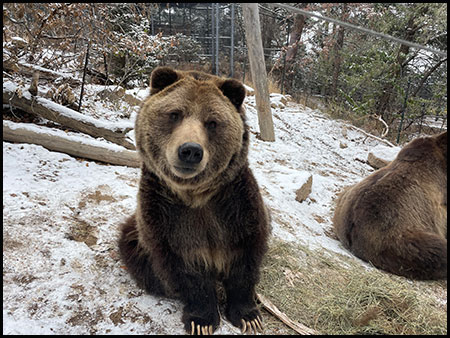
“We believe these changes are going to improve both guest experiences and animal experiences,” said Ruhl. “There are no current plans to welcome cubs to the Zoo, but unfortunately, wildlife officials need to find homes for orphaned cubs nearly every year. If we can give them a second chance at life by providing a safe home for them, we will.”
CMZoo will provide updates on the grizzlies and the new-and-improved guest areas as progress continues.
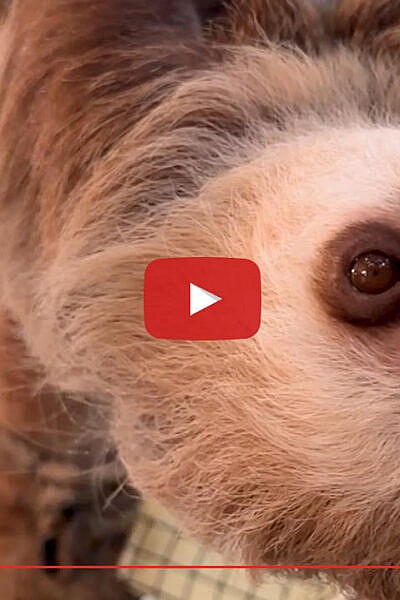

Hoffmann’s two-toed sloth, Aysan, has spent the last few months adjusting to her new life, and her new roommate, in Scutes Family Gallery. Aysan came to CMZoo to join 31-year-old male sloth, Bosco, on a breeding recommendation. As an older sloth, Bosco is very familiar with keepers and guests, and he has helped Aysan come out of her shell.
Aysan is interested in training, especially when her favorite snacks are involved, and is currently working on voluntary injection training. Because keepers have built a trusting relationship with Aysan, she allows them to touch her back and stomach and has already voluntarily participated in x-rays. This training is especially important should Aysan become pregnant in the future.
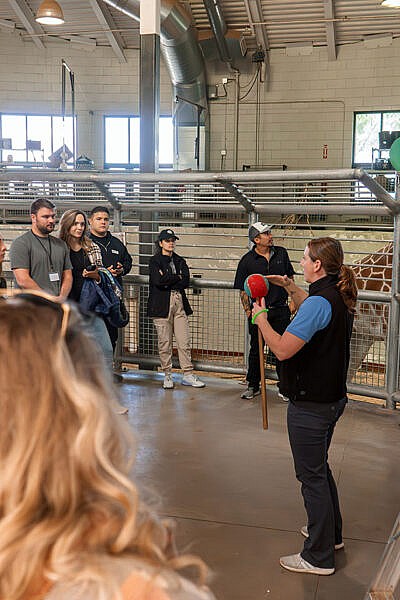

In early November, the International Center for the Care and Conservation of Giraffe (The Giraffe Center) traveled to Bristol Zoo, in the United Kingdom, to host their first giraffe care workshop abroad. Cheyenne Mountain Zoo established The Giraffe Center in 2022 to serve as a resource for giraffe caregivers worldwide.
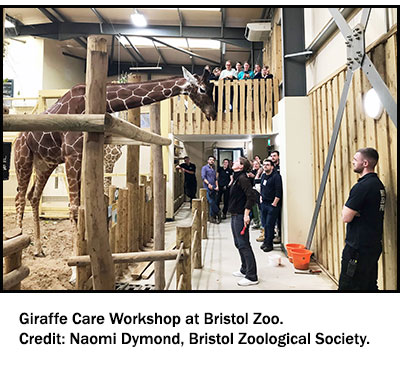
“We have hosted giraffe care workshops all over the U.S. and virtually with teams in other countries, but Bristol Zoo’s workshop was our first international in-person outreach,” said Amy Schilz, senior animal behaviorist at The Giraffe Center. “It’s really helpful for us to work hands-on with teams and their giraffe herds in their facilities. Our training and care teachings share a common foundation, but we can understand their challenges and obstacles better when we experience them, which means we’re better able to customize their training.”
Through their combined decades in the giraffe care field, The Giraffe Center team had previous working relationships with a Bristol Zoo giraffe keeper, who managed logistics for the workshop in England so The Giraffe Center team could focus on the 4-day workshop curriculum. Attendees included Bristol Zoo’s giraffe care team and British and Irish Association of Zoos and Aquariums’ Giraffe Focus Group members. The workshop included lecture-style presentations, group discussions, role-playing and actual practice focused on giraffe nutrition, natural behaviors, hoof anatomy and care, and positive reinforcement training.
“Just like when we’re training animals, we use small approximations to move through training steps with our workshop attendees,” said Diana Miller, giraffe specialist at The Giraffe Center. “Before we start training with the giraffe, we practice hands-on with humans, so we’re presenting the best polished training to the giraffe. Instead of realizing questions you need to ask while you’re working with a giraffe, you can recognize what you don’t know while you’re practicing with a human.”
Practicing hoof care on humans isn’t as far-fetched as it sounds. Attendees move through the motions they will present to giraffe, with Schilz and Miller guiding them. They role play where they’ll stand, where the giraffe needs to stand, how they’ll hold their target stick and hoof trimming tools, how they’ll deliver verbal and physical cues, how they’ll access reinforcers – like crackers or carrots – and how quickly to reinforce the right behaviors. They also practice trimming hooves on cadaver hooves from reputable sources.
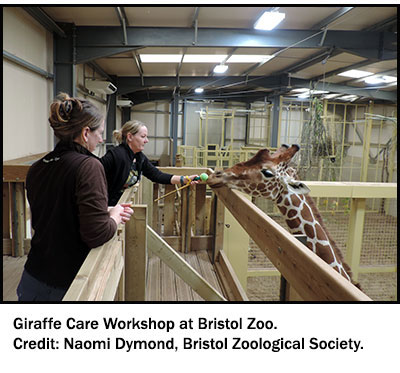
“The fact that Bristol Zoo invested in this workshop shows how dedicated their team is,” said Schilz. “When we started working with their giraffe, it was even more obvious how strong their relationships are with their keepers. The Bristol Zoo giraffe were comfortable, social and engaged, and that gives us a great foundation to build upon with new or different techniques.”
In positive reinforcement training, one of the first questions The Giraffe Center team asks themselves is, ‘what does the animal need to know in order to know something else?’ Because giraffe are often food motivated, the first thing they need to know is how to eat politely.
“Teaching a giraffe to eat and stay still while they’re eating is a prerequisite for blood draws, ultrasounds, hoof care and more voluntary behaviors,” said Miller. “It’s a lot harder than you think to teach that. You’re learning to communicate as a giraffe-caregiver team, and you’re finding a balance between maintaining their excitement for the reward food item and teaching them they can trust that we will deliver it when they stand still.”
The teams worked together to make progress on hoof care, stand-still behavior, target training and more. They also shared insight on giraffe nutrition and natural foraging behaviors, and other topics central to good giraffe welfare in human care.
The Giraffe Center team’s experience with their first overseas workshop further ignited their passion for giraffe care and for supporting the people who can truly make a difference in setting the standard for excellent giraffe care.
“In 2015, when we were starting training programs, we were focused on showing people what’s possible,” said Schilz. “Now, we’re really honing our teaching skills. We’re constantly pursuing education, connecting with other experts in our field and sharing what we’re learning, so we can be the best central resource for other giraffe organizations.”
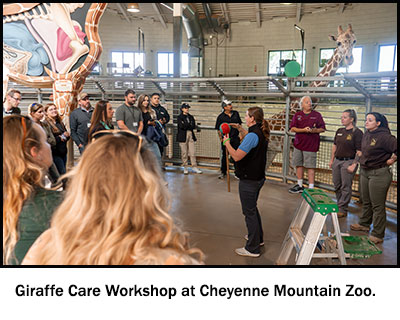
Cheyenne Mountain Zoo made an investment in The Giraffe Center that gives all giraffe caregivers access to a dedicated team focused entirely on giraffe care and conservation.
“The more we host these workshops, the more we learn and share,” said Miller. “It’s all about creative collaboration. We take the same science and apply it differently depending on the animals, humans and environment they are in. That’s our goal for the Giraffe Center – to be a custom-built resource for other giraffe care teams.”
The Giraffe Center is booking workshops for giraffe care teams and giraffe enthusiasts globally. For more information, visit cmzoo.org/giraffecare.
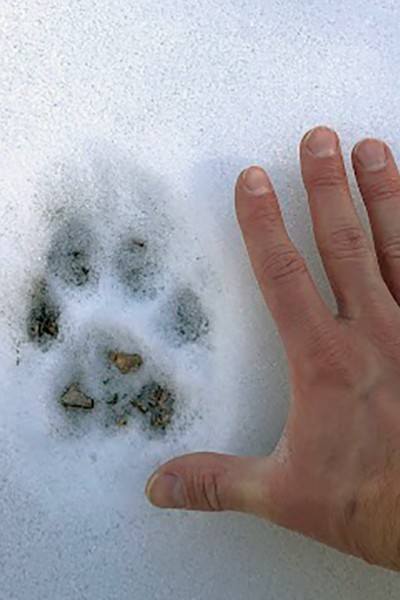


During the winter months, many Coloradans stay active by enjoying the state’s 300 days of sunshine or embracing the alpine lifestyle and hitting the slopes. For some nature enthusiasts, it can be hard to know where to start in the winter world of outdoor adventure. Cheyenne Mountain Zoo’s EdVenture team has just the program: Outdoor School!
Outdoor School is a year-round program that includes special winter-themed courses. Our partners at Children’s Hospital Colorado say helping kids stay active, despite colder temperatures and shorter days, has countless mental and physical health benefits.
“As outdoor and environmental educators, we see first-hand the health benefits of spending time outside in nature,” said Russell Friedman, education specialist at CMZoo. “Learners of all ages can enjoy safe, natural settings at the Zoo and at spaces around our community as a way to boost their mental and physical health.”
Studies have shown that spending just 15 minutes outside each day can immensely improve a person’s mental state of mind and overall happiness. Outdoor School’s variety of programs can be both soothing and exciting.
“Whether we are hiking on our Zoo’s behind-the-scenes nature trail, learning about animals by spending time with them or meditating outside, we are providing ways for all our participants to practice healthy habits for mind and body,” Friedman said.
Each course is $24.75 and includes daytime admission to the Zoo that day. In January and February, Outdoor School programming includes nature-driven courses focusing on animals’ winter weather adaptations, animal tracking 101, mindfulness practices in nature and animal habitats for winter. Students learn through hands-on activities and unique nature-based experiences.

No matter the season, there are always fun opportunities to enjoy the outdoors, and the EdVenture team at CMZoo is committed to helping people discover those outlets. Cooler temperatures add to the experience, too.
“With each program, we emphasize the first principle of Leave No Trace, which is ‘Plan Ahead and Prepare’,” Friedman said. “We provide a checklist prior to each workshop so everyone is prepared for time outside, especially during the winter season. We also constantly move throughout the Zoo, so our bodies are staying active and warm. When necessary, we will take learning breaks in many of the Zoo’s heated indoor animal habitats to help connect participants to wild places and our wildlife.”
New Outdoor School programs are added to the schedule throughout the year, so consider letting CMZoo’s EdVenture team help your family members take safe steps into nature in a variety of ways. See current programming and register at cmzoo.org/outdoorschool.
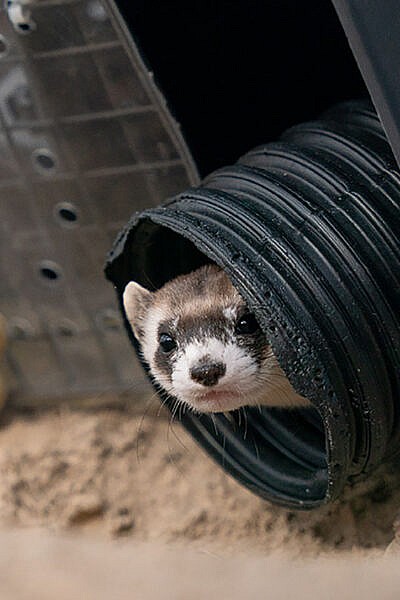

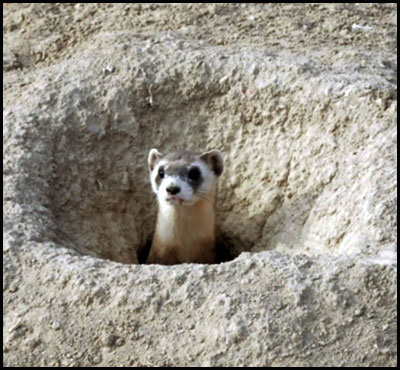 It was a big year to celebrate for black-footed ferret (BFF) conservation enthusiasts. Including Cheyenne Mountain Zoo’s kits, 417 BFF kits were born into the program. That’s the most kits born in a single year program-wide in a decade!
It was a big year to celebrate for black-footed ferret (BFF) conservation enthusiasts. Including Cheyenne Mountain Zoo’s kits, 417 BFF kits were born into the program. That’s the most kits born in a single year program-wide in a decade!
Led by the Association of Zoos and Aquariums Black-Footed Ferret SAFE (Saving Animals From Extinction) and U.S. Fish & Wildlife Service, breed-and-release programs at Cheyenne Mountain Zoo, Smithsonian National Zoo and Conservation Biology Institute, Phoenix Zoo, Toronto Zoo, Louisville Zoo and National Black-Footed Ferret Conservation Center work together to save the species. CMZoo contributed 21 kits this year and released 12 kits and 2 beyond-breeding-age adults into wild conservation habitats in Colorado.
Once the kits are old enough to live independently – around 3 months old – they are transported from the conservation center at CMZoo to BFF ‘boot camp,’ in Fort Collins, where they spend time in a pre-release pen that simulates the opportunities and challenges they’ll encounter in the wild. When they prove they can hunt, find shelter and survive in the pre-release pen, they are cleared for wild release. Ferrets that don’t graduate from boot camp are brought back to support breeding efforts or serve as ambassadors for their species, if they’re too old to reproduce.
In November, CMZoo staff and board members traveled to protected prairie lands in Pueblo, Colo., to see the ferrets run free into their new home.
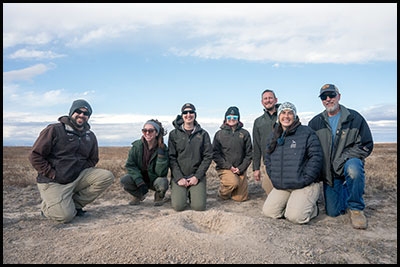
“We invite staff from all departments to participate in releases, and we especially aim to bring staff from The Loft and EdVenture department, who can share their inspiration when guests asks about Rouge – a BFF that lives in The Loft,” said Jeff Baughman, field conservation coordinator at CMZoo. Baughman manages the BFF breeding program at CMZoo and has attended annual releases for nearly 20 years. ”The experience is rewarding, and it inspires us to inspire others to care for wildlife and wild places, and continue our work contributing to conservation efforts.”
Native to prairies stretching from Mexico to Canada, BFFs were thought to be extinct in the 1980s. During Western frontier explorations in the early 1900s, cargo ships from Europe and Asia inadvertently brought sylvatic plague to North America. The spread of the plague bacteria by fleas among prairie dogs (and other animals), combined with poisoning and eradication programs led by newly settled farmers and ranchers who saw prairie dogs as pests, drastically reduced the prairie dog population. Because prairie dogs are their main food source, BFF populations declined dramatically along with them.
On Sept. 26, 1981, a ranch dog named Shep caught a BFF. Shep’s catch led to the discovery of a small population of the elusive animals in Meeteetse, Wyoming. Since then, zoos, U.S. Fish and Wildlife, National Black-footed Ferret Conservation Center and other organizations have banded together to breed, prepare, release and monitor BFFs to increase the population.
Because they or their offspring could be released to the wild, every effort is made to keep the BFFs born and raised at CMZoo as wild as possible. So, they are not visible to CMZoo guests. Guests can visit Rouge, a former breeding male that now lives in The Loft.
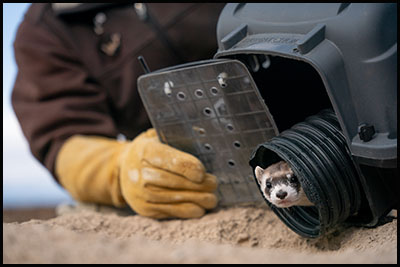
Prior to the CMZoo releases last month in Pueblo, the sites were managed for sylvatic plague through oral bait vaccines for prairie dogs living on these sites and dusting to eliminate plague-carrying fleas. Sylvatic plague transferred by fleas is now prairie dogs’ primary threat – and BFFs need prairie dogs as their primary food and shelter source. BFFs and other prairie species live in abandoned prairie dog tunnels.
“Being in the field with people who advocate for BFFs but haven’t released them before takes me back to my most inspiring black-footed ferret release at a ranch in New Mexico in 2008,” said Baughman. “On our way to the ferret release area we drove through a huge herd of powerful bison. It helped me imagine a time when bison, swift foxes, burrowing owls, prairie dogs and black-footed ferrets were abundant together in the prairie.”
“We released them before dusk and after sunset we went back to spotlight and monitor the first ferret we had released,” said Baughman. “To our surprise, it was above ground with two swift foxes. They looked almost the same size from a distance and their interaction seemed more curious and playful than threatening. It was as if they were old friends reunited after a long time apart. It looked like they were dancing on the prairie, under the moonlight, as they have done for thousands of years. The bison, the swift foxes and the prairie were truly magical. That was a day that I will remember forever.”
Bison have a similar story to the black-footed ferret. They were nearly eradicated to extinction and are now recovering with the help of people dedicated to them. Baughman sees them as proof that animals can possibly recover, and if people work together, they could potentially bring back some of the prairie ecosystem to its original splendor.
“Zoos have been so instrumental in those recoveries,” said Baughman. “The work we’ve been doing at CMZoo for 42 years, helping black-footed ferrets recover, helps the entire ecosystem because prairie species need each other.”
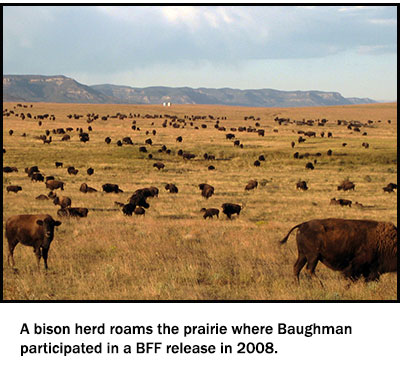
At the core of the prairie’s survival is the prairie dog. Prairie experts estimate that 170 prairie species depend on the prairie dog – and bison make life richer for the prairie dogs, which in turn support the BFFs. Bison graze differently than livestock. They cut the grass instead of uprooting it, which benefits natural vegetation, healthy drainage and nutrient-rich soil for the mostly herbivorous prairie dogs. The bison’s literal heavy presence also loosens soil, which prairie dogs dig to create tunnels that house their colonies and later become homes for BFFs and other species, like box turtles and burrowing owls.
“It is a complicated balance that we want to support without getting too involved in,” said Baughman. “Ultimately, we want a future that doesn’t need our breed-and-release program because it’s sustaining itself in the wild.”
Until then, Baughman and his inspired team will continue the work with the support of CMZoo guests and members. Back at the conservation center up above CMZoo, the meticulous yearly cycle of preparing for another breeding year has already begun. They recently welcomed new breeding females and males and are moving them through the simulated light cycle that triggers their natural instinct to breed in the spring. After such a successful breeding year, program partners are optimistic about 2024.
Every CMZoo guest helps support this important program because 75 cents from every admission goes to Quarters for Conservation, which helps fund BFF conservation and other important efforts around the world. Since 2008, Q4C has raised nearly $5 million for these programs. To learn more about the black-footed ferret breeding program and CMZoo’s Quarters for Conservation program, visit cmzoo.org/conservation.